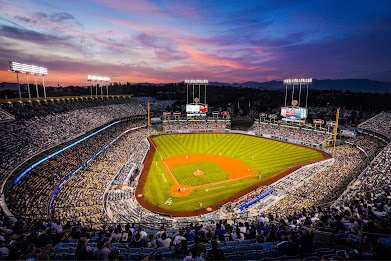Dodger Stadium, with its striking architecture and storied past, stands as an iconic landmark in the vibrant cityscape of Los Angeles. Home to the Major League Baseball team, the Los Angeles Dodgers, this stadium isn’t just a sports venue—it’s a symbol of community, history, and the enduring spirit of America’s favorite pastime.
Located in the Elysian Park neighborhood, Dodger Stadium was constructed in 1962, making it the third-oldest ballpark in the United States, only surpassed by Fenway Park in Boston and Wrigley Field in Chicago. However, despite its age, Dodger Stadium still holds the title as the largest baseball stadium by seating capacity, accommodating a whopping 56,000 fans.
The stadium’s history is interwoven with the narrative of the Dodgers. After moving from Brooklyn to Los Angeles in 1958, the team originally played at the Los Angeles Memorial Coliseum. However, the Coliseum was a temporary solution, and plans for Dodger Stadium—a baseball-specific venue—were soon underway.
Built in a then-semi-rural Chavez Ravine, the stadium was part of a controversial and ambitious urban renewal project. Despite early opposition and lawsuits, the project moved forward, forever changing the landscape of Los Angeles.
The design of Dodger Stadium is a testament to the mid-century modern architecture prevalent in Los Angeles at the time of its construction. Its clean lines, cantilevered decks, and expansive vistas of the San Gabriel Mountains make it a truly unique and visually stunning venue.
Inside the stadium, fans are treated to a baseball experience that blends tradition with modernity. The stadium retains its classic charm with its well-maintained field and nostalgic organ music, while modern amenities, including HD video screens and upgraded concession stands, ensure a comfortable and engaging fan experience.
Beyond baseball, Dodger Stadium has played host to a myriad of events over the years, ranging from concerts featuring world-renowned musicians like The Beatles and Elton John, to special sporting events like the NHL Stadium Series. It’s also been a filming location for various movies and television shows, further cementing its status as a cultural icon.
The surrounding area, known as Dodger Town, enhances the stadium experience with its festive atmosphere, complete with fan-favorite food vendors and fanfare. The smell of grilled Dodger Dogs—a stadium staple—and the sound of cheering fans create an infectious energy that’s hard to resist, even for the casual baseball viewer.
Yet, the heart of Dodger Stadium lies in the memories it’s housed over the decades: the roar of the crowd during Kirk Gibson’s legendary home run in the 1988 World Series, the awe during Sandy Koufax’s perfect game, the cheers accompanying Clayton Kershaw’s no-hitter. These moments are etched into the stadium’s legacy, making it more than just a venue, but a home for extraordinary baseball history.
Dodger Stadium, with its enduring charm and rich history, serves as a shining testament to Los Angeles‘ love for baseball. Its significance extends beyond the boundaries of the baseball diamond, standing as a beacon of community spirit and a vital piece of the city’s cultural fabric. Whether you’re a die-hard baseball fan or just an admirer of iconic architecture, a visit to Dodger Stadium offers a unique and memorable slice of Los Angeles life.
Unraveling the Wonders of Nature at the Natural History Museum of Los Angeles County
MacArthur Park: A Vibrant Cultural Melting Pot in the Heart of Los Angeles


Recent Comments